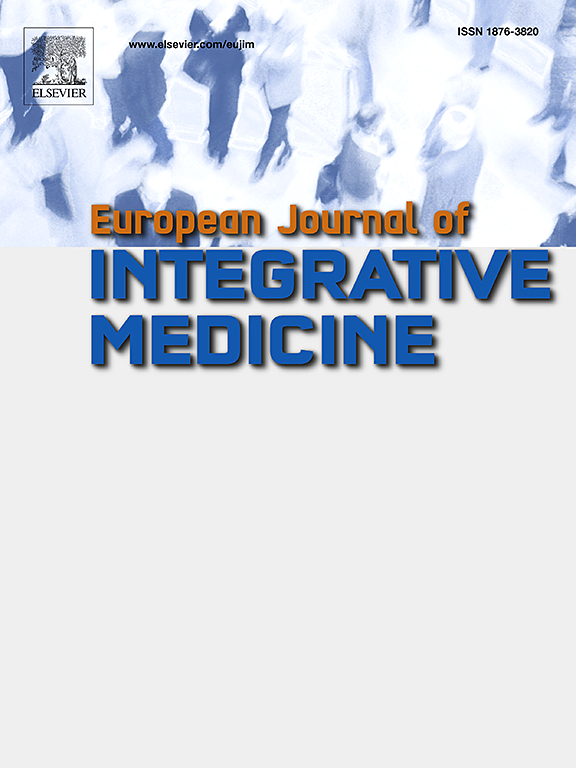边缘反射治疗纤维肌痛:一项非药物治疗的定性研究
IF 1.7
4区 医学
Q3 INTEGRATIVE & COMPLEMENTARY MEDICINE
引用次数: 0
摘要
欧洲风湿病协会联盟(EULAR)在其2017年的论文中建议在五年后进行更新,以确定是否对评分较低的疗法进行了进一步的试验,以及是否出现了用于治疗纤维肌痛的新疗法。边缘反射疗法是一种针对由边缘大脑网络和核功能改变引起的特定问题的反射疗法。本研究的目的是探索边缘反射疗法作为一种非药物治疗纤维肌痛的潜力,通过(1)评估患者在接受每周6至8次边缘反射疗法的初始疗程后,其疼痛、疲劳和睡眠质量等纤维肌痛症状的生活体验是否发生了变化,以及(2)评估定期维持治疗后症状是否有任何变化。方法采用有目的的同质样本,包括年龄在18岁及以上,诊断为纤维肌痛,并在研究前完成了每周6至8次的边缘反射疗法课程的参与者。数据收集采用半结构化访谈,访谈录音,逐字抄录,匿名。然后使用解释性现象学分析进行数据分析。研究人员对三名患有纤维肌痛的女性进行了访谈,以详细了解每周6至8次的边缘反射疗法的影响,以及对纤维肌痛症状的维持治疗及其对疼痛、疲劳和睡眠质量的影响。以下主题被确定为“纤维肌痛的体验”,“边缘反射疗法的体验”和“边缘反射疗法的整体影响”。参与者报告说,边缘反射疗法改善了他们的症状,疼痛减轻,疲劳减轻,睡眠更安稳。这种症状的改善通过定期治疗得以维持。结论本定性研究为边缘反射疗法对纤维肌痛患者身心功能的影响提供了新的认识。这些初步发现为进一步研究确定边缘反射疗法作为非药物治疗纤维肌痛症状的潜力提供了宝贵的开端。本文章由计算机程序翻译,如有差异,请以英文原文为准。
Limbic reflexology for the management of fibromyalgia: A qualitative investigation of a non-drug treatment
Introduction
The European Alliance of Associations for Rheumatology (EULAR) in their 2017 paper recommended that an update be conducted after five years to determine whether further trials had been conducted for therapies which had scored low and whether any new therapies had emerged for the management of fibromyalgia. Limbic reflexology is a reflexology approach which targets specific problems that arise from altered function of the limbic brain network and nuclei. The aim of this study was to explore the potential of limbic reflexology as a non-drug treatment for the management of fibromyalgia, through (1) assessing if a person’s experience of living with the fibromyalgia symptoms of pain, fatigue and sleep quality changed after receiving an initial course of six to eight weekly limbic reflexology sessions, and (2) assessing whether any changes in symptoms were maintained with regular maintenance sessions.
Methods
A purposive homogenous sample was used to include participants who were aged 18 and over, had a diagnosis of fibromyalgia and had completed a course of between six to eight weekly limbic reflexology sessions prior to the study. Semi-structured interviews were used for data collection, the interviews were audio recorded, transcribed verbatim, and anonymised. Interpretative phenomenological analysis was then used for the data analysis.
Results
Three women with fibromyalgia were interviewed to gain a detailed account of the impact of six to eight weekly limbic reflexology sessions, plus maintenance sessions on symptoms of fibromyalgia and its impact on their experience of pain, fatigue, and sleep quality. The following themes were identified “The experience of fibromyalgia”, “The experience of limbic reflexology”, and “The holistic impact of limbic reflexology”. Participants reported limbic reflexology improved their symptoms with less pain, reduced fatigue, and more restful sleep. This improvement in symptoms was maintained with regular sessions.
Conclusion
This qualitative study provides new insight into the impact of limbic reflexology on physical and mental function among women living with fibromyalgia. These initial findings provide an invaluable start for further research to determine limbic reflexology’s potential as a non-drug treatment for the management of fibromyalgia symptoms.
求助全文
通过发布文献求助,成功后即可免费获取论文全文。
去求助
来源期刊

European Journal of Integrative Medicine
INTEGRATIVE & COMPLEMENTARY MEDICINE-
CiteScore
4.70
自引率
4.00%
发文量
102
审稿时长
33 days
期刊介绍:
The European Journal of Integrative Medicine (EuJIM) considers manuscripts from a wide range of complementary and integrative health care disciplines, with a particular focus on whole systems approaches, public health, self management and traditional medical systems. The journal strives to connect conventional medicine and evidence based complementary medicine. We encourage submissions reporting research with relevance for integrative clinical practice and interprofessional education.
EuJIM aims to be of interest to both conventional and integrative audiences, including healthcare practitioners, researchers, health care organisations, educationalists, and all those who seek objective and critical information on integrative medicine. To achieve this aim EuJIM provides an innovative international and interdisciplinary platform linking researchers and clinicians.
The journal focuses primarily on original research articles including systematic reviews, randomized controlled trials, other clinical studies, qualitative, observational and epidemiological studies. In addition we welcome short reviews, opinion articles and contributions relating to health services and policy, health economics and psychology.
 求助内容:
求助内容: 应助结果提醒方式:
应助结果提醒方式:


